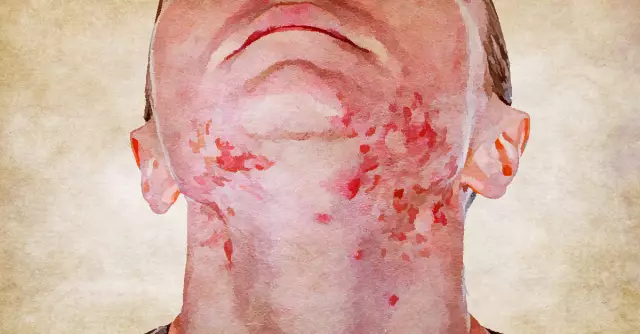- Author Rachel Wainwright [email protected].
- Public 2023-12-15 07:39.
- Last modified 2025-11-02 20:14.
Salivary glands

The salivary glands are glands that belong to the anterior part of the digestive tract. Thanks to the enzymes produced that promote the formation of saliva, the salivary glands are involved in the digestion process and are necessary to ensure the normal state of the human oral cavity.
The structure of the salivary glands
The salivary glands can be divided:
- By size - into small and large;
- By the nature of the secreted secretion - into proteinaceous, mucous and mixed.
The small salivary glands (mucous and mixed), located in the submucosal layer of the lips, cheeks, palate and tongue, include:
- Palatine;
- Cheek;
- Labial;
- Lingual;
- Molar.
The large salivary glands are paired organs and have a great influence on digestion. There are three types of large salivary glands:
- The parotid salivary gland, located in the posterior jaw fossa, the anterior section of which lies on the masseter muscle. It is the largest of all the salivary glands and its mass varies from 20 to 30 g. The parotid gland is covered with a dense parotid fascia and is divided into lobules by bridges. The external carotid artery, the facial nerve with its main branches and large veins pass inside this gland. The blood supply to the parotid gland occurs through the branches of the superficial temporal artery;
- The submandibular salivary gland with an excretory duct into the anterior sublingual region, located in the submandibular triangle. The blood supply to the submandibular gland occurs through the branches of the facial artery;
- The sublingual salivary gland with the excretory duct on the sublingual meatus and the sublingual fold, located in the sublingual space on the maxillary hyoid muscle. Blood supply occurs through the branches of the lingual artery.
Functions of the salivary glands
There are several main functions of the salivary glands, namely:
- Secretion of hormone-like substances (endocrine);
- The production of mucous and protein components of saliva (exocrine);
- Excretion of metabolic products (excretory);
- Filtration of blood plasma components from the capillaries of the oral cavity into saliva (filtration).
Enzymes for the formation of saliva enter the oral cavity through the ducts of the salivary glands, which open under the tongue and at the level of the upper large molars.
Saliva, carrying out the initial chemical processing of food and enveloping it with mucin (a special mucous substance), contributes to the formation of a food lump.
Salivary enzymes such as maltase, peroxidase, amylase, oxidase, ptyalin and other protein substances continue to affect food after it enters the stomach.
Saliva, formed by enzymes produced by the salivary glands, contributes to:
- Chewing food and articulation;
- Strengthening the taste of products;
- Protect teeth from thermal, mechanical and chemical damage.
In addition, saliva provides antibacterial protection (local immunity) of the oral cavity, as well as protection of teeth from caries and demineralization.
Diseases of the salivary glands
Among the diseases of the salivary glands, salivary stone disease is most common.
In this disease, stones (calculi, sialoliths) prevent the free flow of saliva from the ducts of the salivary glands, which leads to the development of an inflammatory process in the tissues of the gland. The main symptoms of the disease are:
- Swelling in the cheek and in front of the ear (parotid salivary gland) or under the jaw (submandibular gland) that increases with food intake
- Unpleasant taste in the mouth that causes suppuration through the salivary duct;
- Soreness that occurs when pressing on a swollen gland;
- An increase in body temperature, chills, weakness and other general signs of the inflammatory process (with an exacerbation of the disease).

Increasing in size, the stone over time completely blocks the flow of saliva, which contributes to the occurrence of infection and requires surgery.
Removal of the stone carries the risk of severe complications in the form of damage to the lingual nerve and trauma to large vessels. In cases where the stone is located in the thickness of the gland or in the deep parts of the duct of the salivary glands, it may be necessary to remove the salivary gland.
Surgical removal of the salivary gland has a number of risks and can lead to:
- Damage to the lingual nerve;
- Injury to the branches of the facial nerve, which can cause disturbances in facial expressions;
- Injury of large vessels of the neck or face with the development of dangerous bleeding;
- Deformation of soft tissues and scarring.
In some cases, the treatment of salivary glands and the removal of stones are carried out using ultra-thin endoscopes, which can significantly reduce the risk of the intervention.
Also, common diseases of the salivary glands include stricture of the duct of the salivary glands. This disease is characterized by a decrease in the lumen of the excretory duct of the gland due to narrowing of its walls, which disrupts the natural outflow of saliva and causes an inflammatory process. Treatment of the salivary glands with this pathology is carried out using sialoscopy, which allows you to expand the narrowed section of the duct.
Mumps, the main symptom of which is inflammation of the salivary glands, can be either infectious (mumps) or occur as a result of hypothermia or infection of wounds located in the oral cavity.
Mumps is characterized by painful swelling of the salivary glands, which makes it difficult to chew food. Other symptoms of the disease include fever (usually up to 38 ° C), loss of appetite, headache and weakness.
Mumps can be uncomplicated, in which only the salivary glands are affected. In some cases, in addition to them, other organs are affected, which leads to the development of such serious diseases as orchitis, myocarditis, meningitis, pancreatitis, meningoencephalitis, arthritis, mastitis, nephritis.
There is no specific treatment for the salivary glands with this disease. Depending on the course of the disease, symptomatic therapy is performed.
Other diseases of the salivary glands include:
- Saladenitis (parenchymal or interstitial);
- Obstructive lesions (polyps)
- Sialdohitis;
- Sjogren's syndrome, Mikulich's disease;
- Sialoses (neurogenic, endocrine, autoimmune).
Found a mistake in the text? Select it and press Ctrl + Enter.






